About Us
4Wall In The News
4Wall Provides Lighting for Weezer's Voyage to The Blue Planet Tour
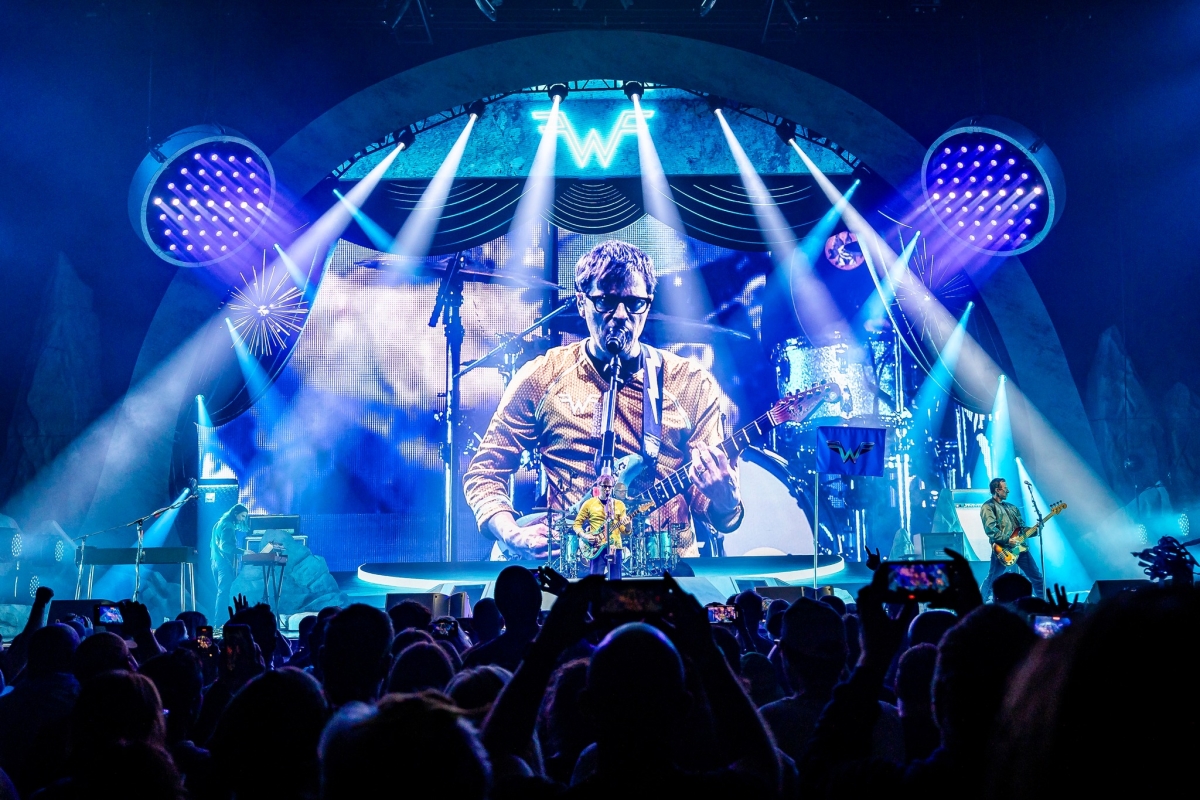
4Wall provided the lighting and rigging gear for the tour, which celebrates the 30th Anniversary of their first album, The Blue Album. The article, which provides more details about the design, was originally posted in Lighting & Sound America magazine and can be found here.
Weezer's Voyage to The Blue Planet Tour celebrated the 30th anniversary of the band's debut Blue Album, which got played in its entirety. Bringing an outer space theme-the show started with a Weezer spacecraft that lifted off, revealing the band underneath- and featuring galactic set pieces hovering above the stage plus video content depicting other planets-the alt-rock band kept a fun vibe all night long. Weezerpedia, the online compendium of information about the band, lays out the show's premise.
"A breaking news report informs the audience that the Blue Planet is dying and that Weezer is being sent to restore it. They board the Betsy 2.0, a shuttle that will take them and the audience on a dangerous voyage to save the Blue Planet. The lights brighten and show the shuttle heading up for liftoff, with fans cheering the group on. As the band plays, the big screen shows Betsy flying through space, traveling through a Weezer-themed space bar, and running into the alien Bokkus, who has a hatred of the group. During a trek through the asteroid belt, Bokkus drains Betsy's shields by hurling pies and other objects at the shuttle. The shuttle crashes, which launches M1 to look for parts as the band plays cuts from the titular album. After the fourth part is found, the shuttle takes off for the Blue Planet.
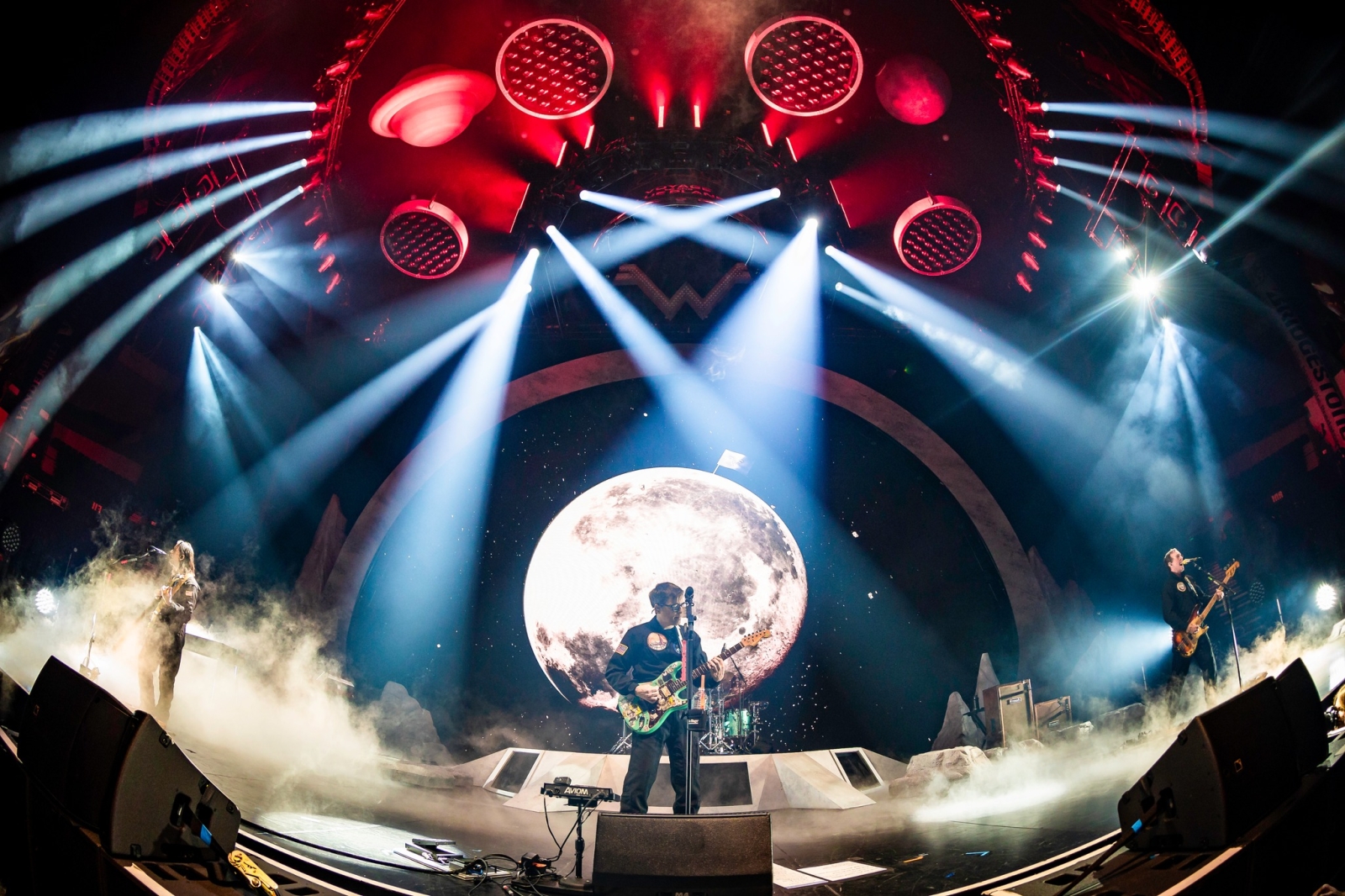
"The planet is found, but it's dying and requires the Blue Album to come back to life. Rivers Cuomo [the band's lead singer] plants a flag adorned with the Flying =W= in the ground, and the band performs the entire album front-to-back. The planet is shown coming back to life, with grass, trees, and buildings growing as they perform. The band lands at the Blue Rocks Amphitheater and are cheered on by the planet's native population of Weezeroids, a species of which Cuomo and the crowd are members. Bokkus finds the amphitheater and attacks with laser cannons, only to be defeated by loudspeakers and the Weezeroids' laser eyes. After the credits roll, a faux news report similar to the one at the beginning of the show plays where Cuomo states that the mission has inadvertently opened up a wormhole and altered the timeline (for example, changing Rivers' name to Kurt), and that they need to fix it before any more damage is caused." - Travis Shirley, show designer/director
Shirley, of Blank Wall Creative, says, "I had the privilege of working with Weezer on their previous tour," he says. "That experience allowed me to get to know their creative vision and how they approach live performances." When planning began for this new tour, he says, "They were confident in the creative direction I could bring to their shows, and the management team was already familiar with my approach to production design."
Shirley says the key was understanding Weezer's brand and vision, and what the band wanted to communicate to the audience. "Because of our successful past collaboration, I could step into this new tour with a strong foundation of trust and a shared understanding of the creative goals. The desire to push creative boundaries led to this new opportunity. We wanted to craft a narrative that would take the audience on a journey through space-an The idea of traveling through space was a way of connecting the band's past and future, Shirley notes. "The space environment felt timeless, expansive, and full of possibilities, which mirrored the diversity of Weezer's catalog. We encountered various elements along the way- each representing different stages of the band's career and the songs that defined those moments. This approach honored the Blue Album's significance but also gave us room to explore other fan favorites and deeper cuts."
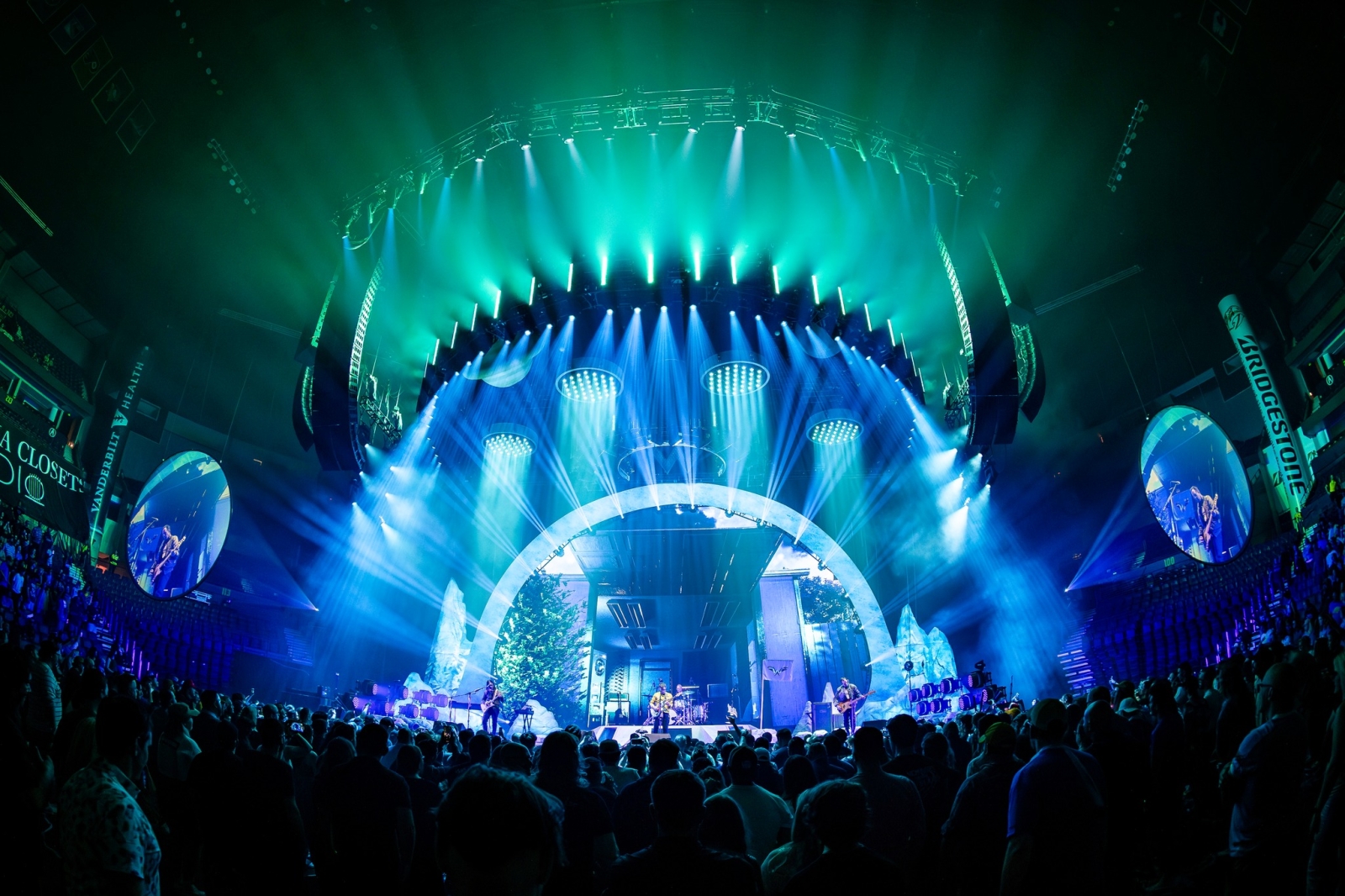
As with every tour, Shirley worked with his team at Blank Wall Creative, integrating production, lighting, and scenic design into a cohesive experience. "This approach allows us to create unique, dynamic moments that work together as a unified whole, rather than treating each design element as a separate entity." That way, he says, "We're able to craft a more immersive, seamless experience for the audience." He also understands the practical constraints of assembling a large-scale tour. "We managed budgets with Weezer's tour manager Thomas O'Keefe, working closely with production manager Tom Addison on truck packs and logistics." Working with Robert Roth, entertainment VP of live events, and David Hunkins, director of live events, at 4Wall Entertainment, the tour's lighting gear supplier, was a fantastic experience, Shirley says. "We've partnered with 4Wall on several previous tours, and their expertise in both lighting and rigging has been invaluable. This is one of the key reasons we continue to work with them: Every project feels like a true collaboration, with a strong focus on providing the right gear, excellent customer support, and a smooth production process."
O'Keefe and Addison have a long-standing relationship with Roth. "We knew 4Wall could not only deliver the fixtures and rigging we needed, but also provide the level of support and flexibility required for a show of this scale," Shirley says. "In terms of the budget, 4Wall was able to work within our parameters and help us source the right equipment at a price that made sense for the production. They've always been top-notch, and it's that level of professionalism and support that's kept us coming back. "This tour has been a personal and professional highlight for me," Shirley adds. "I grew up listening to Weezer - for 25 years, their music has been the soundtrack to so many moments in my life. To design a show for a band I've admired for so long is surreal. From the first conversations on previous tours, it was clear that Weezer's management had a bold goal: to take the band's live stage presence to a whole new level and position them as a true arena rock band worldwide. There was something magical about the way we merged visuals with the music, creating moments that are both nostalgic and fresh. There was a specific moment in the show where the lighting and stage elements perfectly synced with a classic Weezer hit-it's one of those moments that gave me chills every time."
Pre-production was paramount, Shirley notes. Musical director Max Bernstein worked hard to lock in a setlist before production load-in, which provided a huge head start on lighting and video programming. "As is often the case, several key moments in the show didn't fully come to life until we had the band onstage," Shirley says. "It was invaluable to have Ian Haslauer and Pat Wala tackling the bulk of the programming during this time. They were instrumental in shaping the visual narrative of the show." This production featured a significant amount of automation, tightly synced with the lighting and video elements; spending time aligning these components in pre-production was critical to ensuring the show ran smoothly. "The collaborative effort during rehearsals paid off in bringing the vision to life."Shirley notes the contribution of creative producer Isabel Levin. "She excelled at taking the unique challenges of this production and turning them into viable solutions. Her creativity and problem-solving were instrumental in bringing this vision to life. Patrick Wala deserves recognition for his exceptional skill as a video programmer and for being such a fantastic collaborator. I'm excited to seewhere our partnership takes us next. Ian Haslauer-what can I say? Despite having his hands full with programming, he always managed to bring a smile and a laugh, usually just when it was needed most. Lighting director Danielle Dollar was brought to my attention by Tom Addison. He saw something in her, and boy, was he right! Danielle is a bright young star who fits seamlessly into my team and the creative process that unfolds with a
show of this scale. She brought a fresh perspective and energy that elevates the overall production." -Selena Hodom, project manager, TAIT
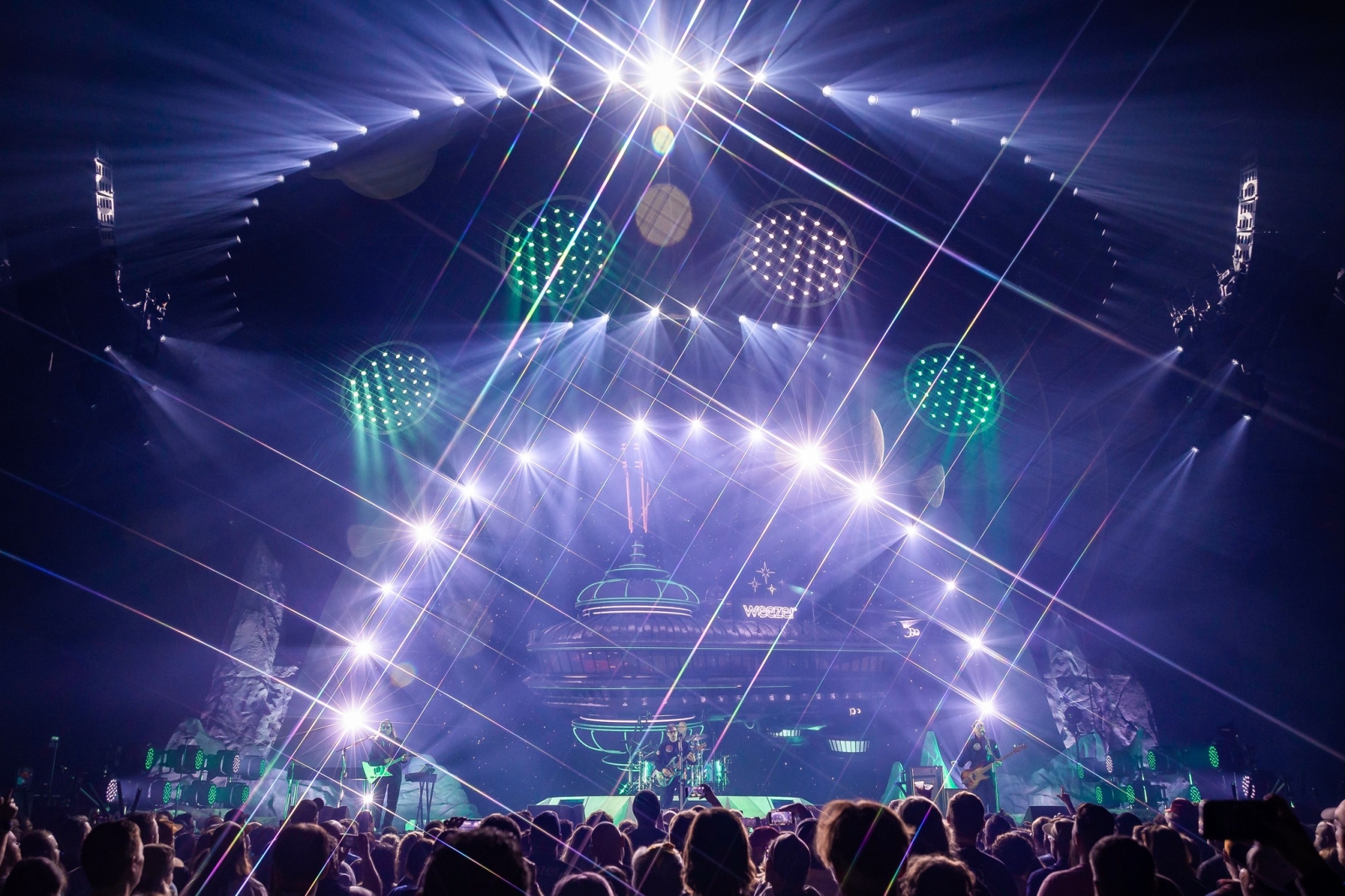
TAIT has worked on several successful shows with Shirley, including Bad Bunny and Karol G. "We worked directly with Travis and his producer Isabel Levin on the initial concepts of the design," Hodom says. "The spacecraft shuttle was provided by ShowFX. We automated the opening reveal of the shuttle blasting off." TAIT provided the staging, launch pad drum riser, custom video screen fascia, and lighting pod frames. The Navigator automation platform controlled all the moving elements, including the planets, space shuttle, Weezer sign, video screen, and lighting pods. "We used a custom circle grill deck riser with plywood ramps, boxes, and polycarbonate windows that allowed light to travel through," she continues. "The riser fascia was painted in our scenic shop by our amazing team. We used a 40-by-60 TAIT Mag Deck rolling stage with an extension upstage and rolling tech platforms. The ease of building a Mag Deck stage was critical to the load-in timeline due to a large number of rigged elements. The lighting pod frames were 7' custom circles. We finished it with a polycarbonate fascia and a custom scenic finish. The four pods were rigged on three points to be able to pan, tilt, and penny roll."
The pods were supported and automated with one-ton Nav Hoists. The planets were inflatables rigged with half-ton Nav Hoists. The Weezer sign was automated to fly in and out during the show. "We also automated the video screen to ease load-in and changeover. All hoists were controlled by TAIT Navigator. TAIT's senior show programmer, Doug Sager, and automation operator, Sean Groves, spent a lot of time with Travis and the Blank Wall Creative team programming and perfecting automation cues and details.
"This was truly a collaborative effort from all the vendors involved. Technical director Matt Geasey did a great job organizing everyone on weekly calls to keep the show moving forward. Travis Shirley's clear vision and ability to tell a story makes him a truly unique talent. The Weezer team, led by Tom Addison, were very involved from the beginning and were a pleasure to work with." - Danielle Dollar, lighting director
"This was my first time as LD for Weezer," Dollar says. "I had previously worked alongside Tom Addison in the fall of 2023. When the band was looking for a new LD Tom pulled me into the team." She ran the show on a full-size grandMA3 console in MA3 mode. "It was my first tour using the MA3 and I utilized all my preproduction time to get my bearings. The selection grid and having 3D built into the software are huge improvements. We spent nine days together in Evansville, Indiana in pre-production. I was present for almost the entirety of the programming.
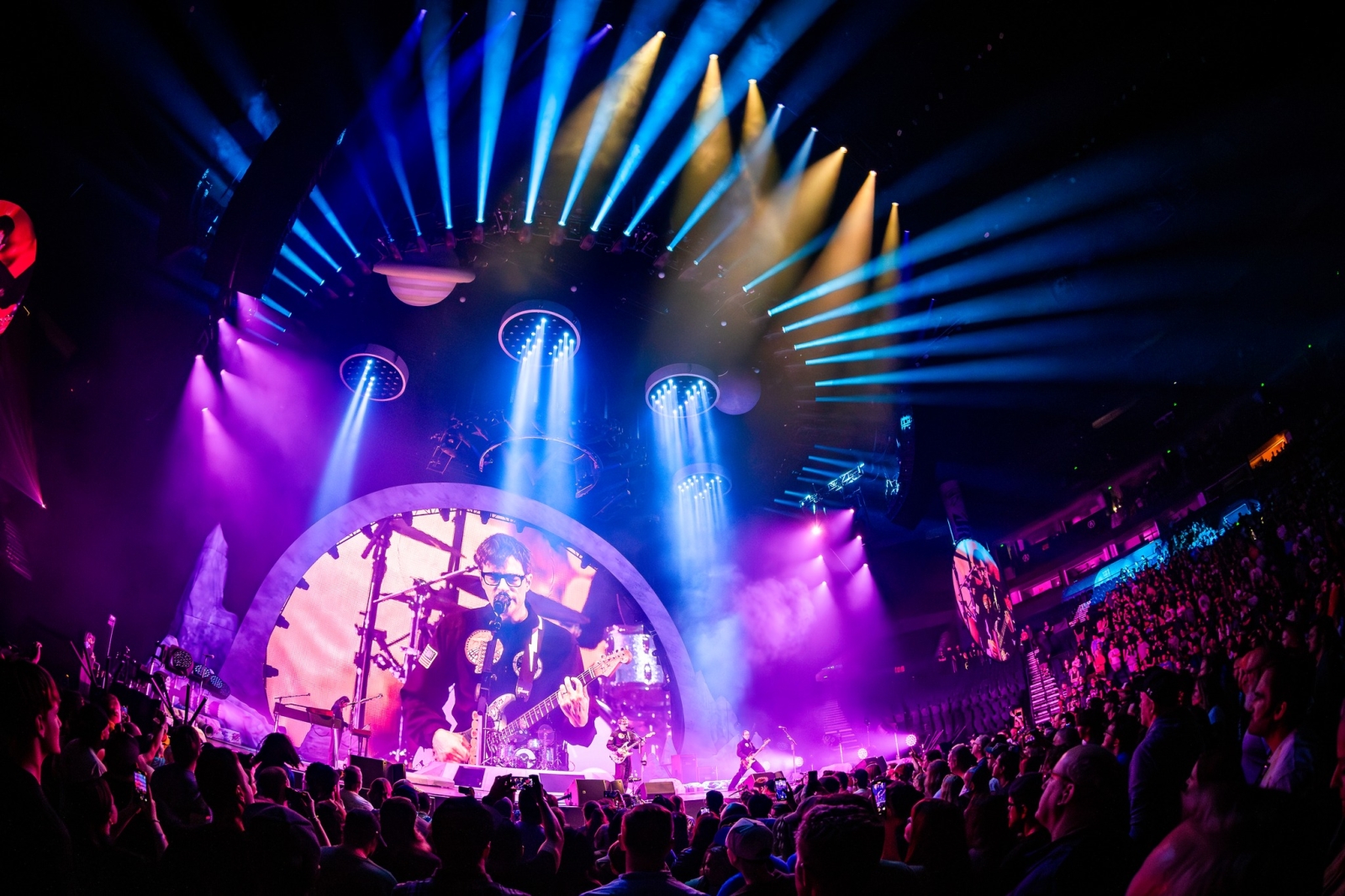
Ian [Haslauer] and I spent many late hours together while he programmed. I like to think I was helpful to him as an encouraging creative energy. We bounced many ideas off each other and had a great time. By the end of it, essentially the whole show was time-coded, with 30-50 cues per song, and many time-coded button presses for each as well as Resolume triggers." Resolume was the tour's media server. Lighting fixtures consisted of 18 Robe MegaPointes in the arch truss lining the LED wall, 99 Robe BMFL WashBeams (located upstage and on the downstage flown truss as well as side flown torms), 39 TMB Solaris Flares on the upstage and midstage flown trusses, 185 Elation ZCL 360i units (36 in each pod), 16 CHAUVET Professional Maverick MK3 Washes mounted on poles (in rocks) on the ground as side fixtures and 26 Chroma-Q ColorForce IIs as ground-based uplight on the rocks. The Elation 360i units, Solaris Flares, and CHAUVET MK3s were all new to Dollar. "I thought the MK3s were the most interesting, as they were in their fully extended channel mode so you could get creative with the pixel mapping. I tweaked only what I felt was necessary, like some time-coded hits that weren't friendly towards the band being a little loose on BPM, then keeping the crowd blinders [the Flares] lively with sing-along moments, which Weezer has many.
"Every department was made up of wonderfully talented and amazing human beings," she continues. "Being so young in my career, I know how much I have to learn, and I couldn't have been more set up for a win by Tom Addison on this. Every day consisted of working directly with automation on things like inflatable planet position specials and moving the rocket and pods in or out of positions as I was focusing. Video lead Marc Crifasi and I always checked in on making sure Resolume was good to go as set changes were made. The carpenter team was always patient with me, [waiting] to finally hang the kabuki as soon as I was done focusing the upstage lights. Special effects tech Chad Whitlock and I were on comms the duration of the show as I called low fog, cold sparks, streamers, and confetti. We all worked
hard and had fun doing it. Directing all those lights every day on my first arena tour would not have been possible without the mentorship of lighting crew chief Charles Teer and lighting techs Freddi Rogers, Daniel Ford, Jesse Figueroa, Alyssa Schneider, Fernando Rosado-Ortiz, and Jeff Mosher." - Jack Edinger, video director
Edinger was located backstage with a switcher desk, engineering rack, and Resolume media server. "The switcher desk was a Ross Vision mixer, not the most current product on the market but still a powerful rig. Ben Renschen and I had fun digging into it. Ben was the video engineer- he's amazing and super patient which I think is such a great quality to have as an engineer, and as a person, for that matter. I appreciate that [video gear supplier NEP] Screenworks has all this older gear that can still get the job done and they trust us to keep it humming along. We used Triax cameras, and we rocked 'em."
Edinger's video world included a standard multiview where he liked to have one monitor with the program cut on the side; seeing the cut isolated and not in the program window of the multiview gave him a third-eye insight into how the cut should flow. "Sometimes it's easy to get trapped in the multiview and not focus on what's going out to the audience. We also had a spy cam at FOH, so we put that feed on a third monitor, and I'd look at that to cut when we were doing different feeds for different screens. That was easier than trying to watch a second ME and not being able to see what the full scene looks like. Ben had something like 50 laptops."Edinger believes the camera operators make each cut sing. "A Les Paul guitar doesn't play itself, right? We had such hard-working shooters: Tony Smith and Mark Crifasi on the two long lenses, and especially Jake Richmond and Sean O'Byrne in the pit. Weezer banged out song after song, there weren't a lot of catch-your-breath moments, and the handheld pit guys gave an insane amount of effort each night." Edinger wanted a '90s MTV-meets-cinematic look but used cameras that could only do interlaced video scanning; thus, they had to find other ways to make it look gritty. "A 14mm lens in the pit helped give some dynamics and action to the cut, and Sean [O'Byrne] would [do a Dutch angle] and fly in to give us the kinetic 'Nirvana Live and Loud '93' look. Jake [Richmond] got a ton of supertight [shots] down the guitar neck stuff, where the depth of field looked gorgeous, giving us that sort of cinema look. We also cranked the shutters to make everything look a little crispy. Since the theme was spacey, we used the fourpointed star filters, and it looked pretty. We had some Panasonic BGH1s as POVs and they looked great."
Since the two side-stage IMAG screens [20' in diameter], were circular, a fisheye lens was used on one [camera] over the shoulder of drummer Pat Wilson. Barco 35K laser projects delivered the imagery. "Screenworks gave us a camcorder with SDI output to use as a spy cam at FOH," Edinger says, "but instead we had Karl Koch [Weezer documentarian] grab it for the Pinkerton [another Weezer album] song and shoot from the stage. It was a total homemovie look, and it worked perfectly with the grittiness of that record. Karl didn't have comms; he just went up there and shot whatever he thought looked cool. We put that on the upstage wall and just let the chaos be the look. Super fun! Karl is a legend. I love crowd shots but, obviously, they have to be the right fit for the band and thesong. Thankfully, Weezer has some absolute bangers on the Blue Album that had every kid and parent screaming. 'Say It Ain't So' and 'Buddy Holly' were big ones. We did an intentional feedback look for 'The Sweater Song;' it kinda just made sense to make it trippy there." Edinger says the video chain was straightforward. Two MEs were used-one to serve the circular IMAGs and one to send to the upstage LED wall plus two outputs to Resolume, programmed by Patrick Wala during rehearsals. The ROE Visual CB5 LED wall was 50' wide by 32' tall. "We didn't have a touring media server op, so servers were back in video with us," Edinger says. "The LD [Dollar] had some controls via her MA3 out at the front-of-house Art-Net and time code feed the server.
"Very, very important to note here," Edinger says. "We took the lids off the engineering rack and made a makeshift ping-pong table. All tour long, when we had downtime, we'd be shredding. At the end of the tour, we had a 16- person, four-day-long Weezer Voyage to the Blue Planet invitational tournament (with Tony Smith as official officiant). Sean [O'Byrne] and Danielle [Dollar] went seven games in an epic battle on the last day of the tour. We had entrances, lights, and full IMAG going. It was beyond insane. The whole Weezer crew, Tom Addison, and The Flaming Lips [support band] people were so fun and cool on this tour." - Craig Overbay, front-of-house engineer
Overbay has been mixing Weezer since 2000. He started on a Midas Heritage/XL4 console, moved to a Yamaha PM5D for 2005, then a DiGiCo D5, and onto a long stint with AVID Profiles before returning to DiGiCo with the Quantum 338. "Over that time, one thing that sticks in my mind as far as software: The ability to have band-pass compression native on the desk is a must-have
feature." Overbay uses DiGiCo's Mustard channel option, adding that it is very useful, as is the company's Spice Rack feature. "The onboard effects are one of the few things I believe could be improved in the product line. For hardware, for the past decade, I have used an API 5500 EQ and a Drawmer 1969 tube compressor on the mix bus; that's been a constant. I try to keep it as straightforward as possible. I try to find the two or three inputs you can build the mix around and I stick to that as much as possible. In the case of Weezer, it is as you would think: Get Rivers' vocal rock solid as possible, then his guitar and Brian [Bell's] guitar; the rest tends to fall in place. That's not to say the rhythm section is not very important, but people usually don't complain about the tonality of the snare drum." Overbay's outboard effects rack consisted of Lake LM 44 on the left and tight sub fills, a Drawmer 1969 API 5500 on the mix bus, a Yamaha SPX 990 on guitar, both Lexicon PCM 42-RC and Eventide Eclipse-RC for vocals, and Roland SRV 2000 digital reverb on drums. Also featured were Ultimate Audio plug-ins via Mac Book Pro: Lexicon 224 on backing vocals, Capitol Chambers on the snare, Pure Plate Reverb-RC on vocals, Studio D Chorus for backing vocals, and an API 2500 compressor. "I used the Waves SuperRack performer running UAD plug-ins on a laptop via Madi," he says "If you are only running effects, it's a fun tool without causing latency issues. "With the advent of digital consoles, a mixer now has the opportunity to work on their mixes in various forms almost anywhere anytime. If you put in the time, you should be rewarded with the results. We had a great crew from Clair, from the systems engineer Ben Bruns to the fly guys." - Chris Bloch, monitor engineer
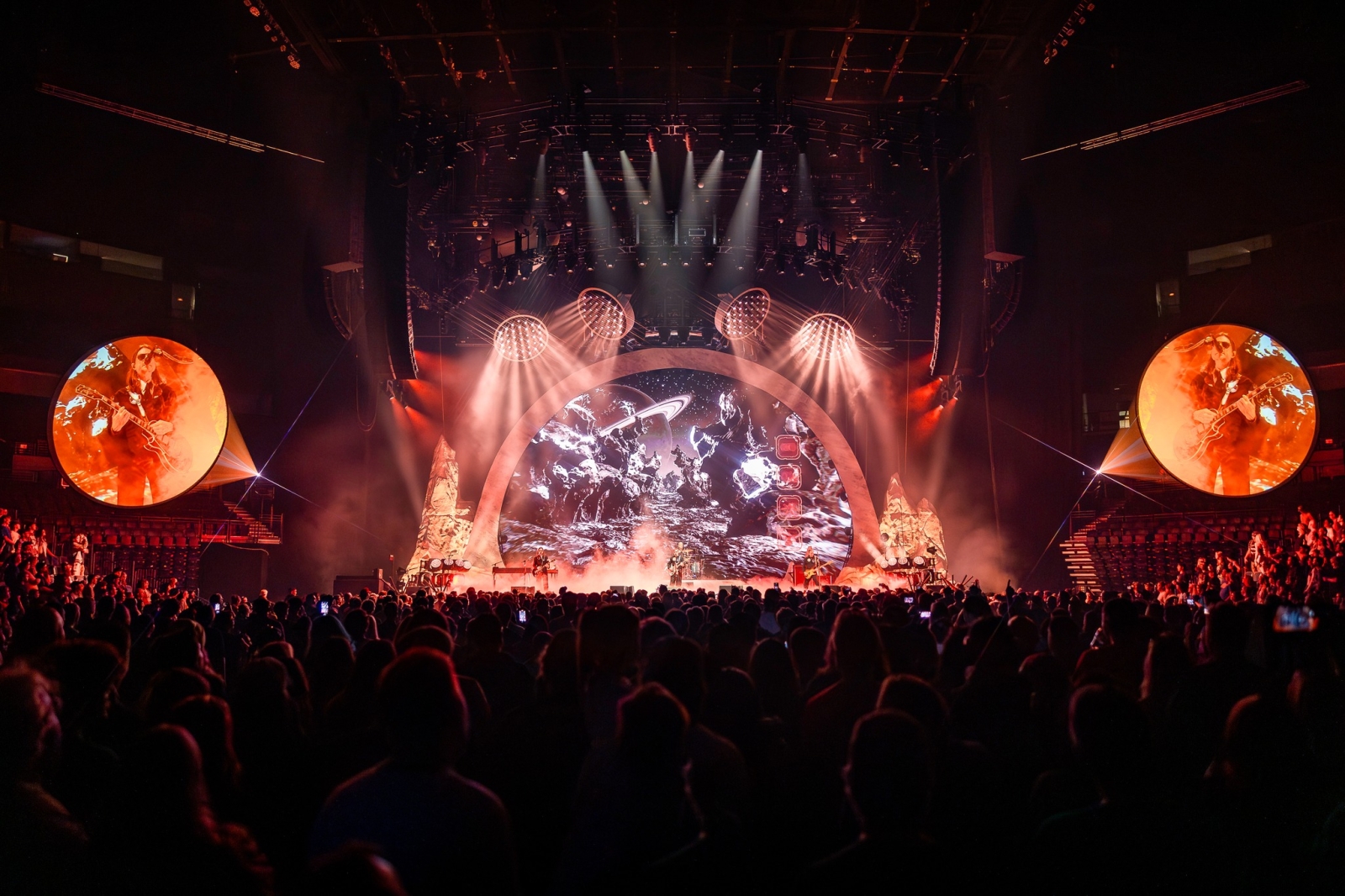
This was Bloch's first time with Weezer. "Tom Addison was kind enough to ask me to be involved and fortunately I was available to work with these absolute legends. I'm using a DiGiCo SD12, but I'm brand-agnostic. Sometimes the band or tour has a strong preference so I will mix on whatever is available or has worked in the past to give the band some continuity, or to work with the vendor based on inventory availability. Recently, I have also used an Avid S6L with Dead & Company, a Yamaha Rivage PM7 with The Judds, and a Midas HD96 with Wynonna. "I'm pretty minimal-just stock DiGiCo effects for this tour," he says. "I also really like the De-esser and audio enhance effect, which adds a nice bit of high-end excitement, kind of like an [Aphex] Aural Exciter I use vocal reverb, snare/toms verbs and I like a Bricasti M7 for a vocal verb and a RND 5045 to get the room tone out of the vocal which is part of the overall ambiance. Also, Rivers' vocal for the Blue Album is a pretty straightforward rock tone, so a lush vocal reverb is definitely NOT it." Bloch notes Craig Overbay has a great relationship with Heil and specifies all
the mics. "We had [Heil's] PR35 on Shure wireless for the vocal; it's pretty much Heil or Audix all around. All are very dynamic microphones, which are great! The PR35 has plenty of cut and there isn't much proximity effect so it was easy to get the vocal to sit in the mix." Stage volume was tightly controlled. "It felt live but not out of control. We were using Plexiglass in front of cymbals only; we had a live bass rig but the guitars were either iso cabs or direct. We also had some subs onstage for Rivers to feel the kick. As far as ears are concerned, it was a mixed bag. Rivers' IEMs were Ultimate Ears UE 11 Pros with ambient filters while Scott, Brian, and Pat are on JH Roxannes. I was on FIR Audio Xenon 6, which I personally love and translate really well. We used Shure PSM1000 [personal monitors] with P10R+ belt packs. "My monitor tech, Kenneth 'Chan' Teaster was excellent. He's very proactive in helping solve problems and managing the audio load-in and load-out. Chan was ableto take care of things without my involvement leaving me to take care of the band and the RF, so it was very helpful." - Ben Bruns, systems engineer
For Bruns, the L-Acoustics K1 line array system was the first and only choice. "A big box moving a lot of air really lets the bass line drive the melody, drums be impactful while leaving space and clarity for vocals and guitars to sing above it," he says. "Craig [Overbay] and I have worked together for years, and his mix is always its best through a giant brown box rig. Our system consisted of sixteen K1s and four K2s [per side] for the main hangs, eight K1s and eight K2 side hangs, eight flown KS28 subs per side, and six blocks of three KS28s on the ground. We had six A15 front fills, hen two d&b [audiotechnik] subs under the drum riser." Bruns notes the tour was a collaborative effort. "Our stage manager, Bill Price, is a smart systems engineer, and Tom Addison is also a great front-ofhouse mixer. The rig we put together loaded in quickly, covered every seat in an impactful and clear way, and went back in the trucks even faster. Tuning was done through M1, and Clair Audio was gracious enough to supply us with the Sound Devices A20-Nexus Go interface, which is a brilliant piece of gear." The Voyage to the Blue Planet Tour concluded in October, but Weezer will be in Japan in January and will kick off a European tour in Aarhus, Denmark in June.
Weezer Voyage to the Blue Planet Tour
Show Director/Designer: Travis Shirley (Blank Wall Creative) Creative
Producer: Isabel Levin (Blank Wall Creative) Lighting Programmer: Ian
Haslauer Lighting Director: Danielle Dollar Lighting Crew Chief: Charles Teer
Video Director: Jack Edinger Video Programmer: Patrick Wala FOH Engineer:
Craig Overbay Monitor Engineer: Chris Bloch Systems Engineer: Ben Bruns
Production Manager: Tom Addison Tour Manager: Thomas O'Keefe Technical
Director: Matt Geasey Automation Chief: Albert Torres Head Rigger: Joanna
Kiriacopoulos Benauer Production Companies: Lighting & Rigging: 4Wall
Entertainment Video: Screenworks Automation/Staging: TAIT Scenery:
ShowFX SFX: StrictlyFX Audio: Clair Global
" I love crowd shots but, obviously, they have to be the right fit for the band and the song. Thankfully, Weezer has some absolute bangers on the Blue Album that had every kid and parent screaming. "
- Edinger
" The space environment felt timeless, expansive, and full of possibilities, which mirrored the diversity of Weezer's catalog. We encountered various elements along the way- each representing different stages of the band's career and the songs that defined those moments. " - Shirley
